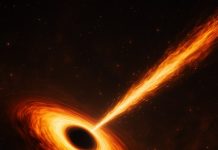
Imagine you’re looking up at the night sky, filled with stars. Every so often, a star might suddenly get very, very bright. This is called a “transient event.”
Scientists found one of these events that was brighter and gave off more energy than any other they’ve seen before. They named it AT2021lwx.
The brightness of this star didn’t just flash and then go away. Instead, it slowly got less bright, kind of like when you turn down a dimmer switch on a light in your room.
It also gave off different types of light, like UV light (which is the type of light that can give you a sunburn) and X-rays (the same kind of thing doctors use to look at bones inside your body).
Scientists also noticed that AT2021lwx was surrounded by a lot of space dust. This dust started to glow a little while after the star got bright.
What’s really interesting about AT2021lwx is that scientists think it might have happened because of a black hole.
You know how a vacuum cleaner can suck up dust and small things lying on the floor? A black hole does something like that, but in space.
It’s a place where gravity is so strong that nothing, not even light, can escape from it.
In this case, scientists think there might have been a giant space cloud made up of tiny particles that got sucked up by a black hole.
In the vast expanses of space, scientists have observed AT2021lwx, the most powerful non-quasar transient ever seen.
This cosmic event, characterized by a single, significant brightening, has drawn attention due to its extreme luminosity and the massive amount of energy it radiates.
A Burst of Light and Energy
This transient event exhibited an increase in brightness by more than 100 times, reaching a luminosity level of 7 x 10^45 ergs per second.
In terms of total radiated energy, it topped off at 1.5 x 10^53 erg, making it the most energetic optical transient observed to date.
The luminosity decrease followed a smooth and exponential pattern.
The energy spectrum in the ultraviolet and optical range resembled a blackbody radiation pattern with a temperature of approximately 12,000 Kelvin.
X-Rays and Dust
Further observations provided possible evidence of X-ray emissions, suggesting a secondary source of energy emission.
A delayed burst of mid-infrared radiation indicated the presence of dust surrounding the transient.
The spectral properties of AT2021lwx bear resemblance to recently spotted optical flares in known active galactic nuclei. However, some distinctive features were absent, making this event unique.
Puzzling Observations
The absence of emission from AT2021lwx over the previous seven years doesn’t align with the typically observed short-term, unpredictable variability seen in quasars.
Furthermore, the event’s extreme luminosity and prolonged timescale make it unlikely to be the result of a single solar-mass star’s disruption.
While the luminosity could potentially be explained by the disruption of a considerably larger star, the odds of such an event happening are quite slim.
A Dormant Black Hole Awakens
A plausible explanation for AT2021lwx’s activity could be a dormant black hole, with a mass ranging from 100 million to 1 billion times that of our Sun, accreting a giant molecular cloud.
If this is the case, AT2021lwx would represent an extreme instance of the known scenarios involving black hole accretion.
In conclusion, AT2021lwx presents a fascinating mystery for astronomers.
Its remarkable brightness, energy output, and the characteristics of its spectra challenge our current understanding of cosmic events and offer an exciting opportunity for future research.
The study was published here.
Copyright © 2023 Knowridge Science Report. All rights reserved.



